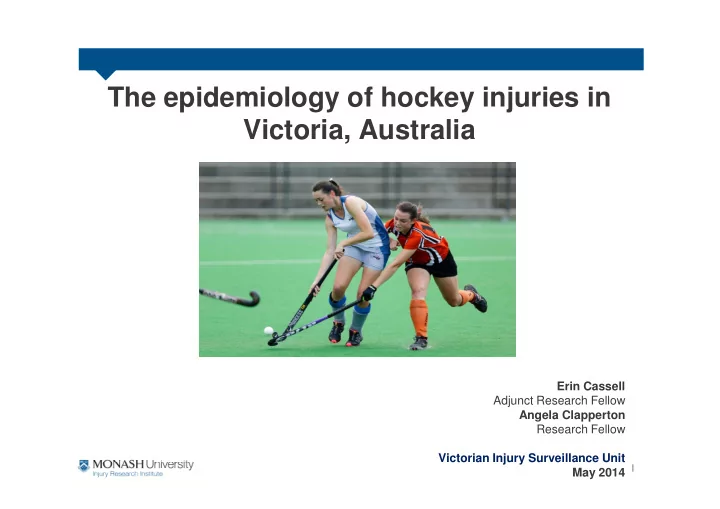

The epidemiology of hockey injuries in Victoria, Australia Erin Cassell Adjunct Research Fellow Angela Clapperton Research Fellow Victorian Injury Surveillance Unit May 2014
Data sources (datasets held by VISU) � Hospital admissions: Victorian Admitted Episodes Dataset (VAED) - Admissions to all public and private hospitals in Victoria - Coded to ICD-10-AM - Chapter 20 External Causes: Codes for Activity, Causes, Place � Emergency Department (ED) presentations, non-admissions: - Victorian Emergency Minimum Dataset (VEMD) - ED presentations to 39 public hospitals, - Drop-down menu: minimum injury dataset includes narrative � Sports participation data: ERASS national annual survey (persons aged 15+) (Victoria oversampled for minor sports)
Data years analysed � Main Analysis : 2010/11 – 2012/13 (3 years) � Trends: frequency 2002/03 – 2012/13 (11 years) rate 2002/03-2009/10 (8 years) Population � All ages for frequency, adults only for rates, both sexes, organised and unorganised sport � Mainly community-level participants
Ranking of sports for serious injury, Victoria Adult hospital admissions (16 Sports), 2007/08 – 2009/10 Rank based on frequency Rank based on rate per 100,000 adult participants 1. 1. Australian Football Australian Football 1. Australian Football 1. Australian Football 2. Soccer 2. Hockey 3. Basketball 3. Soccer 4. Netball 4. Basketball 5. Cricket 5. Netball 6. Rugby 6. Cricket 7. Tennis 8. Hockey Source: Cassell E, Kerr E, Clapperton A. ‘Adult sports injury hospitalisations in 16 sports: football codes, other team ball sports, team bat and stick sports and racquet sports.’ Hazard education 2012, 74, Victorian Injury Surveillance Unit, Monash Injury Research Institute 2012.
Trend in frequency of injury 2002/03 – 2012/13 (all ages) 800 714 700 643 638 631 629 601 608 600 560 526 ed injury 604 479 500 500 450 450 534 534 Frequency of hospital-treated 522 522 523 523 520 520 502 489 admissions 400 450 421 395 ED presentations 363 300 all hospital-treated 200 119 120 111 110 110 107 105 99 104 87 84 100 0 2002/03 2003/04 2004/05 2005/06 2006/07 2007/08 2008/09 2009/10 2010/11 2011/12 2012/13 Year of injury
Trend in rate per 100,000 adult participants 2000 1900 1848 1754 1800 1683 1600 ticipants 1500 1508 1400 1272 1263 1189 1103 1345 1379 1379 Rate per 100,000 ADULT partic 1200 1200 admissions 1000 1028 1017 ED presentations 926 800 860 all hospital-treated 600 392 375 348 338 255 400 263 243 235 200 0 2002/03 2003/04 2004/05 2005/06 2006/07 2007/08 2008/09 2009/10 Year of injury
Gender
Age
Body Region Injured (Grouped) Admissions ED presentations Head/face/neck – 36% Head/face/neck - 35% Upper extremity – 43% Upper extremity - 35% Trunk - 2% Trunk - 2% Lower extremity - 17% Lower extremity - 25%
Commonest injury diagnoses Admissions (n=341) ED Presentations (n=1647) 1. Fracture of wrist/hand 29% 1. Open wound to head 18% 2. Fracture of skull/facial bones 14% 2. Fracture of hand/wrist 11% 3. Open wound to head 11% 3. Dislocation/sprain/strain ankle/foot 9% 4. Dislocation/sprain/strain knee 6% 4. Dislocation/sprain/strain wrist& hand 7% 5. Intracranial (incl. concussion) 4% 5. Superficial injury of head 6% 6. Fracture lower leg including 4% 6. Dislocation/sprain/strain knee 5% ankle
Causes of injury 1. Hit/struck by equipment – ball, bat 67% admissions 65% ED presentation 65% ALL 2. Fall 12% admissions 11% ED presentations 11% ALL 3. Hit/struck/crush by person 2% admissions 6% ED presentations 5% ALL
Direct hospital costs – admissions only n=341 (2010/11-12/13) Total cost: $1.2million AUD Mean cost per case: $3,577 AUD Mean cost per case: $3,577 AUD Range: $656 - $26,415 AUD
Data limitations � Hospital-based collections - capture biased to acute and serious injury - NSW pop. health survey - only 15% of injured sports participants are treated in hospital (Mitchell et al. 2010) � Injury cases on hospital datasets underestimated Substantial missing data on sport being played Substantial missing data on sport being played � Lack of information and mechanisms/circumstances of injury – VAED all data coded - no coding of mechanism of injury and no narrative. VEMD narrative data of variable quality � Uneven commitment from hospital ED management and staff Data quality is variable
Feasibility of sports injury data collection � Difficult to get funding for a stand-alone Sports Injury Surveillance System � ED surveillance - ICECI is a better alternative – core and modules � SportsInjury Tracker – community sports injury on-line surveillance system system
What do we know about community level hockey injury? � Comparatively few studies – all but two descriptive � One prospective cohort study (Western Australia) but risk factor analysis not done – low number of hockey injury cases. � No case control studies to investigate risk and protective factors � No case control studies to investigate risk and protective factors � One published evaluation: of protective eyewear in US high school hockey found eyewear reduces head and face injuries ( Kriz et al, 2012)
Research needs � More injury surveillance to underpin research and prevention � More analytical studies to determine risk/protective factors – focus on head injury � More interventions and evaluations All photographs courtesy of www.sportsonline.net.au
Recommend
More recommend